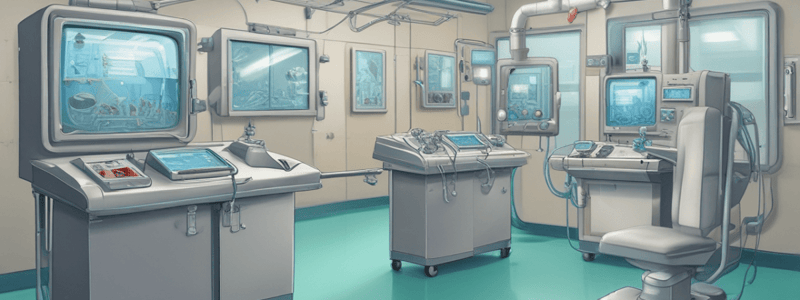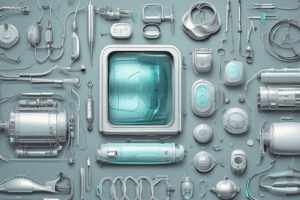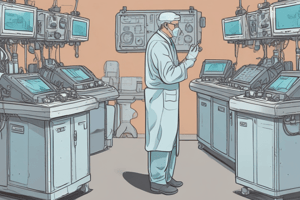Podcast
Questions and Answers
What is the primary purpose of inspecting surgical devices after being unloaded from the washer-disinfector?
What is the primary purpose of inspecting surgical devices after being unloaded from the washer-disinfector?
- To test the sharpness of cutting edges
- To inspect for cleanliness, stains, corrosion, cracks, and breakage (correct)
- To ensure devices are free from corrosion
- To check for completeness of device sets
Why is it recommended to check devices under magnification?
Why is it recommended to check devices under magnification?
- To inspect for corrosion
- To test the sharpness of cutting edges
- To inspect for small pieces of bioburden or debris (correct)
- To check for completeness of device sets
What should be done with devices that are damaged, incomplete, or malfunctioning?
What should be done with devices that are damaged, incomplete, or malfunctioning?
- Report them immediately to the supervisor (correct)
- Clean them again in the washer-disinfector
- Use them for a different surgical procedure
- Place them in a separate device set
What is the purpose of checking cannulated devices?
What is the purpose of checking cannulated devices?
Why is it important to inspect devices with an outer insulation coating?
Why is it important to inspect devices with an outer insulation coating?
What is the primary reason for making a visual inspection of the load before re-processing?
What is the primary reason for making a visual inspection of the load before re-processing?
What happens to items that have excessive wetness after manual cleaning and disinfection?
What happens to items that have excessive wetness after manual cleaning and disinfection?
Why is it essential to disassemble devices before cleaning?
Why is it essential to disassemble devices before cleaning?
What should be done with devices that have visible soil or staining after manual cleaning and disinfection?
What should be done with devices that have visible soil or staining after manual cleaning and disinfection?
What is the purpose of documenting manually cleaned items and nonconformances?
What is the purpose of documenting manually cleaned items and nonconformances?
What is the primary purpose of checking the edges of clamping RMD during quality control?
What is the primary purpose of checking the edges of clamping RMD during quality control?
What is the benefit of using a computerized track and trace system in the CSSD?
What is the benefit of using a computerized track and trace system in the CSSD?
Why is it essential to check screws on jointed RMD for tightness during the cleaning process?
Why is it essential to check screws on jointed RMD for tightness during the cleaning process?
What is generated when a barcode label is scanned by the specialist preparing the tray?
What is generated when a barcode label is scanned by the specialist preparing the tray?
What happens when a new processing cycle begins in a computerized track and trace system?
What happens when a new processing cycle begins in a computerized track and trace system?
When arranging devices in a tray, what is the primary consideration?
When arranging devices in a tray, what is the primary consideration?
What is the recommended method for holding forceps together to prevent tangling?
What is the recommended method for holding forceps together to prevent tangling?
What should be checked against the checklist for a specific surgical instrument tray?
What should be checked against the checklist for a specific surgical instrument tray?
What should be done with devices that require special sterilization methods?
What should be done with devices that require special sterilization methods?
What should be done with forceps with ratchets after sterilization?
What should be done with forceps with ratchets after sterilization?
Study Notes
Device Inspection
- Ensure free movement of device parts and no sticking joints; use water-based lubricant if needed.
- Check clamping RMD edges for overlap and confirm proper meshing of teeth.
- Tighten all screws on jointed RMDs, as they may loosen during cleaning.
Assembly and Tracking Systems
- Inspect and function-test devices before assembling into trays.
- Many CSSDs adopt computerized track and trace systems for accurate tracking of devices and trays.
- Track and trace typically involves handheld barcode readers connected to PCs to log each tray's information.
- Scanning barcode labels generates packing lists and unique labels for each tray.
Inspection and Cleaning Protocols
- Unload surgical devices from the washer-disinfector and inspect for cleanliness, stains, corrosion, and functional integrity.
- Conduct critical inspections on RMDs for cleanliness, focusing on joints, serrations, and crevices.
- Ensure movable parts like hinges and jaws function smoothly and check for alignment and closure of ratchets.
- Inspect cannulated devices for patent channels and test telescopes and light cables per manufacturer instructions.
Quality Checks for Manually Cleaned Devices
- Reject items with visible soil or staining; items must be dry before entering IAP room.
- Report damaged items immediately; ensure devices are correctly disassembled for adequate cleaning.
- Document any nonconformities and rejected items using a pre-printed tray checklist and manual label gun.
Assembly of Surgical Instrument Trays
- Arrange items from left to right based on procedure usage; scalpel handles on the left, needle holders on the right.
- Consider size and surgeon/nurse preferences while ensuring an accurate checklist is followed for consistency.
- Verify all contents against the checklist to avoid errors.
- Use instrument pins or forceps to secure forceps together and reduce tangling.
- Follow manufacturer instructions for sterilization and assembly, ensuring all surfaces are exposed to sterilants and maintain forceps with ratchets open.
Studying That Suits You
Use AI to generate personalized quizzes and flashcards to suit your learning preferences.
Related Documents
Description
Inspection and function testing of surgical devices after sterilization, including checks for cleanliness, stains, corrosion, and damage.




